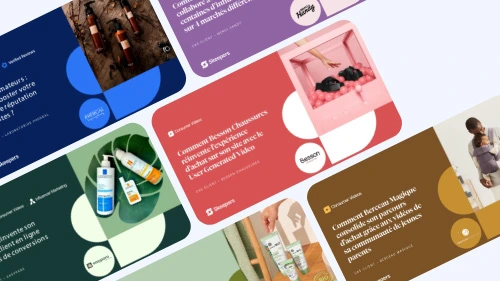In today’s fast-paced digital world, mobile devices have become the primary means for consuming content. Vertical video content, in particular, has seen a dramatic shift in how it’s consumed, with an increasing number of viewers watching videos on their smartphones and tablets.
The vertical video trend has emerged as a direct response to the way people naturally hold their mobile devices. Unlike the traditional horizontal format, vertical videos are designed to fit seamlessly into the portrait orientation of smartphones, providing a more intuitive and engaging viewing experience.
Optimizing videos for mobile viewing is no longer just a nice-to-have; it’s a necessity. With the majority of social media platforms now supporting and even prioritizing vertical video content, adopting this format is crucial for reaching and engaging your audience effectively.
The Rise of Mobile Video Consumption

The surge in mobile video consumption has been nothing short of revolutionary. According to recent statistics, mobile video consumption has grown by over 100% each year, with more than 75% of all video views worldwide now occurring on mobile devices.
Popular platforms have played a significant role in prioritizing and promoting mobile video. TikTok, for instance, has skyrocketed in popularity by offering an engaging, vertical video experience that caters specifically to mobile users. Instagram Stories and Reels have also embraced vertical video, allowing users to create and consume short, dynamic content easily. Snapchat, one of the pioneers of vertical video, continues to be a favorite among younger audiences for its quick, immersive video format.
These platforms have not only popularized vertical video but have also set new standards for mobile content consumption. As users become more accustomed to consuming video content in a vertical format, the need for brands and creators to optimize their videos for mobile has become increasingly important.
Benefits of Vertical Video for Mobile Users
Vertical video offers several benefits for mobile users:
- Ease of Viewing: Vertical videos fit perfectly on mobile screens without requiring users to rotate their devices, providing a seamless and user-friendly experience.
- Better Engagement: Vertical videos often result in higher engagement rates. They occupy the entire screen, capturing the viewer’s attention more effectively than horizontal videos with letterboxing.
- Increased Immersion: By utilizing the full screen, vertical videos create a more immersive experience, making viewers feel more connected to the content.
- Platform Compatibility: Many popular social media platforms, such as Instagram, TikTok, and Snapchat, are optimized for vertical video, ensuring that content reaches a broader audience in the format they prefer.
Embracing vertical video is essential for anyone looking to create impactful and engaging content in today’s mobile-first world. By understanding its significance and benefits, creators can better meet the needs and preferences of their audience.
Why Vertical Video Matters
Enhanced User Experience on Mobile Devices
Vertical video is revolutionizing the way we consume content on mobile devices. By aligning with the natural orientation of smartphones, vertical videos offer a seamless and intuitive viewing experience. Users no longer need to rotate their devices or deal with the inconvenience of black bars on either side of the screen.
Increased Engagement and Retention Rates
The impact of vertical video on user engagement and retention is profound. Because vertical videos occupy the full screen, they eliminate distractions and capture the viewer’s undivided attention. Studies have shown that vertical videos tend to have higher completion rates and lower abandonment rates compared to their horizontal counterparts. The immersive nature of full-screen vertical video keeps viewers engaged for longer periods, leading to better retention and a more memorable content experience.
Best Practices for Creating Vertical Videos
When creating vertical videos, it’s crucial to use the correct aspect ratios and resolutions to ensure your content looks professional and fits seamlessly on mobile devices. Here are the most common specifications:
Aspect Ratios:
- 9:16: This is the standard aspect ratio for vertical videos on most social media platforms, including Instagram Stories, TikTok, Snapchat, and Facebook Stories.
- 4:5: Ideal for Instagram feed posts, offering a vertical but slightly wider view that stands out in the feed.
Resolutions:
- 1080 x 1920 pixels: Full HD resolution for 9:16 aspect ratio videos.
- 1080 x 1350 pixels: For 4:5 aspect ratio videos, providing a crisp and clear display on mobile devices.
Tips for Framing and Composition
Proper framing and composition are key to making your vertical videos visually appealing and engaging. Here are some tips to help you get it right:
1. Center Your Subject: Keep the main subject or focal point of your video in the center of the frame. This ensures that the most important elements are easily visible and not cut off on smaller screens.
2. Use Headroom Wisely: Avoid too much empty space above the subject’s head. Proper headroom creates a balanced and professional look.
3. Embrace the Rule of Thirds: Divide the frame into thirds both horizontally and vertically, and place key elements along these lines or at their intersections. This creates a more dynamic and interesting composition.
4. Vertical Movement: Utilize vertical movements and angles to make the most of the vertical format. Panning up or down, and shooting from low or high angles can add depth and intrigue to your videos.
5. Close-Ups: Since mobile screens are smaller, close-up shots are effective in showcasing details and expressions. They help convey emotions and keep viewers engaged.
Recommendations for Editing Software and Tools

Choosing the right editing software and tools can significantly enhance the quality of your vertical videos. Here are some recommendations:
- Adobe Premiere Pro: A powerful and versatile editing software that supports vertical video formats. It offers advanced features like color grading, motion graphics, and seamless integration with other Adobe products.
- Final Cut Pro: Ideal for Mac users, Final Cut Pro provides robust editing tools and supports vertical video formats. Its intuitive interface and powerful features make it a favorite among professional video editors.
- InShot: A mobile-friendly editing app that’s perfect for creating vertical videos on the go. InShot provides a range of editing features, including trimming, splitting, adding music, and applying filters.
- Canva: Known for its graphic design capabilities, Canva also offers video editing tools that are perfect for creating vertical videos. It’s great for adding text overlays, animations, and other visual elements.
By following these best practices, you can create stunning vertical videos that capture attention, engage viewers, and enhance your mobile content strategy.
Technical Considerations
To ensure your vertical videos look their best on mobile devices, it’s crucial to focus on video quality. Here are some key factors to consider:
- High Resolution: Always shoot and export your videos in high resolution, preferably 1080 x 1920 pixels for a 9:16 aspect ratio. This ensures clarity and sharpness on mobile screens.
- Lighting: Good lighting is essential for high-quality videos. Natural light or professional lighting equipment can significantly enhance the visual appeal of your videos.
- Stabilization: Use a tripod or a stabilizer to avoid shaky footage. Smooth and stable videos are more pleasant to watch and appear more professional.
Importance of Fast Loading Times and Mobile-Friendly Formats
Fast loading times and mobile-friendly formats are critical to keep viewers engaged. Here’s how to optimize your videos for speed and compatibility:
1. Compression: Compress your videos without sacrificing quality. Tools like HandBrake or Adobe Media Encoder can help reduce file size while maintaining clarity.
2. Formats: Use formats that are widely supported by mobile devices and platforms. MP4 is the most common and efficient format for high-quality, fast-loading videos.
Audio Considerations for Vertical Videos
While visual elements are crucial, audio quality should not be overlooked. Here are some tips to ensure your audio enhances your vertical videos:
1. Clear Audio: Ensure your audio is clear and free from background noise. Use high-quality microphones and, if possible, record in a quiet environment.
2. Balance: Balance the audio levels to avoid distortion. Consistent audio levels throughout the video make it easier for viewers to follow along.
3. Captions and Subtitles: Include captions or subtitles, as many mobile users watch videos with the sound off. This makes your content accessible to a wider audience.
4. Music and Sound Effects: Use music and sound effects to enhance the viewing experience. Ensure they complement the visuals and do not overpower the main audio content.
By paying attention to these technical considerations, you can ensure your vertical videos are high-quality, load quickly, and provide an engaging audio-visual experience for mobile viewers.
Distribution Strategies
To maximize the reach and impact of your vertical videos, it’s essential to distribute them on platforms that support and prioritize this format. Here are some strategies for leveraging social media platforms:
1. TikTok: As a platform built around vertical videos, TikTok is ideal for engaging a young, dynamic audience. Use trending hashtags, participate in challenges, and collaborate with influencers to boost visibility.
2. Instagram Stories and Reels: Instagram’s Stories and Reels features are perfect for vertical videos. Regularly post engaging content, utilize interactive features like polls and Q&A, and take advantage of Instagram’s algorithms to reach a broader audience.
3. Snapchat: With its emphasis on vertical content, Snapchat is great for reaching younger demographics. Create compelling Snaps and Stories, use geofilters and lenses, and engage with users through interactive content.
4. YouTube Shorts: YouTube has also entered the vertical video space with Shorts. Utilize this feature to create short, engaging videos that can reach a global audience. Make sure to optimize your content for search with relevant keywords and hashtags.
5. Facebook Stories: Leverage Facebook Stories to reach a diverse audience. Cross-promote your Instagram Stories to Facebook for extended reach and engagement.
Conclusion
The vertical video trend is not just a fleeting fad—it’s a transformative approach that aligns perfectly with the way consumers engage with content on their mobile devices. By adopting vertical video in your marketing strategies, you can create more immersive and engaging experiences for your audience.
With the rise of platforms like TikTok, Instagram Stories, and YouTube Shorts, vertical video has proven to be a powerful tool for capturing attention and driving engagement. From enhanced user experiences to increased retention rates, the benefits of vertical video are clear.
As you move forward, embracing vertical video can set your brand apart in a crowded digital landscape. Start experimenting with vertical formats, optimize your content for mobile viewing, and leverage the unique advantages of vertical video to connect with your audience in new and meaningful ways. The future of video marketing is vertical—don’t get left behind.



















